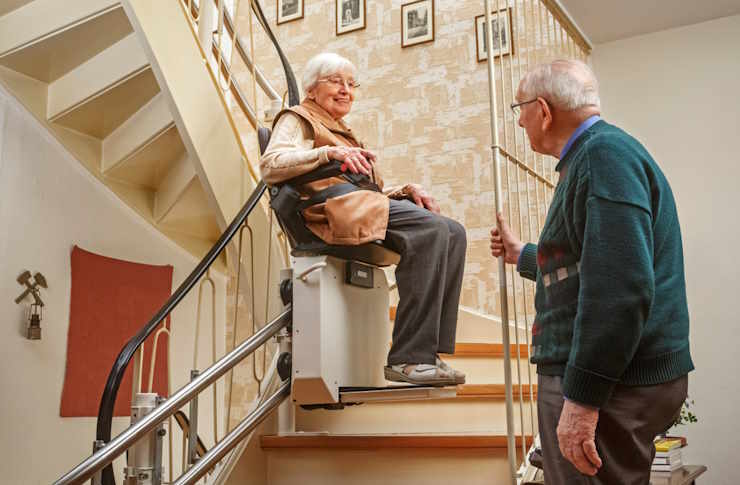Standing Stair Lift
Standing stair lifts offer a specialized mobility solution for individuals who have difficulty navigating stairs but can remain standing during transport. These devices are particularly beneficial for people with certain mobility challenges, knee problems, or those who find it uncomfortable to sit during stair navigation. Unlike traditional seated stair lifts, standing models feature a platform where users can stand while being safely transported between floor levels, making them an ideal choice for narrow staircases or users with specific physical needs.

What Makes Standing Stair Lifts Different
Standing stair lifts operate on a similar rail system to traditional seated models but feature a standing platform instead of a chair. Users step onto the platform, secure themselves with safety straps or rails, and are transported smoothly along the staircase. These lifts typically include fold-down support features, safety sensors, and emergency stop controls. The standing position can be more comfortable for individuals with hip flexibility issues or those who experience discomfort when sitting. The compact design also makes them suitable for staircases where space is at a premium, as they require less clearance than seated alternatives.
Standing Stair Lifts: Key Features and Benefits
Modern standing stair lifts incorporate several safety and convenience features designed to ensure secure transportation. Most models include adjustable support rails, non-slip platforms, and multiple safety sensors that detect obstacles or irregularities during operation. The weight capacity typically ranges from 250 to 350 pounds, depending on the manufacturer and model. Battery backup systems ensure operation during power outages, while smooth start and stop mechanisms provide comfortable rides. Many units feature swivel platforms at the top and bottom landings, allowing users to face the appropriate direction when stepping on or off the lift safely.
Standing Stair Lift For Seniors: Addressing Specific Needs
For seniors considering mobility solutions, standing stair lifts can address specific age-related challenges. Many older adults experience stiffness in their hips or knees that makes sitting and standing repeatedly uncomfortable or difficult. The standing position eliminates the need to bend joints significantly, reducing strain and discomfort. Additionally, seniors who use walking aids can often maintain better control of their mobility devices while using a standing lift. The intuitive controls and safety features are designed with senior users in mind, featuring large, easy-to-operate buttons and clear visual indicators for safe operation.
Installation Requirements and Considerations
Installing a standing stair lift requires professional assessment of the staircase structure and dimensions. The rail system must be securely mounted to the stairs themselves, not the wall, ensuring stability and safety. Straight staircases are ideal candidates, though curved rail options are available for more complex layouts. Electrical requirements typically involve a standard household outlet at either the top or bottom of the stairs. Installation usually takes several hours and includes comprehensive testing and user training. Building codes and local regulations may apply, particularly in multi-unit dwellings, so checking requirements beforehand is advisable.
Cost Considerations and Provider Comparison
Standing stair lifts represent a significant investment, with pricing varying based on features, staircase configuration, and installation requirements. Understanding the cost structure helps in making informed decisions about this mobility solution.
| Provider | Product Type | Features | Cost Estimation |
|---|---|---|---|
| Stannah | Standing Stairlift | Battery backup, slim design, safety sensors | $3,000 - $5,000 |
| Bruno | Electra-Ride Elite | Continuous charge rail, diagnostic display | $3,200 - $5,500 |
| Harmar | Standing Platform Lift | Heavy-duty construction, weather-resistant options | $2,800 - $4,800 |
| AmeriGlide | Standing Stair Lift | Compact design, dual rail system | $2,500 - $4,200 |
Prices, rates, or cost estimates mentioned in this article are based on the latest available information but may change over time. Independent research is advised before making financial decisions.
Maintenance and Long-term Considerations
Regular maintenance ensures optimal performance and extends the lifespan of standing stair lifts. Most manufacturers recommend annual professional servicing, which includes lubrication of moving parts, battery testing, and safety system checks. Users should perform basic maintenance tasks such as keeping the rail clean and checking for loose connections or unusual sounds during operation. Warranty coverage typically ranges from one to five years, depending on components and manufacturer. Many providers offer service contracts that include regular maintenance visits and priority repair services, which can be valuable for ensuring consistent operation and peace of mind.
Standing stair lifts provide an effective mobility solution for individuals who need assistance navigating stairs while maintaining an upright position. Their specialized design addresses specific comfort and space requirements while incorporating comprehensive safety features. When considering this mobility aid, evaluating individual needs, staircase configuration, and long-term maintenance requirements helps ensure the most suitable choice for enhanced home accessibility and independence.




